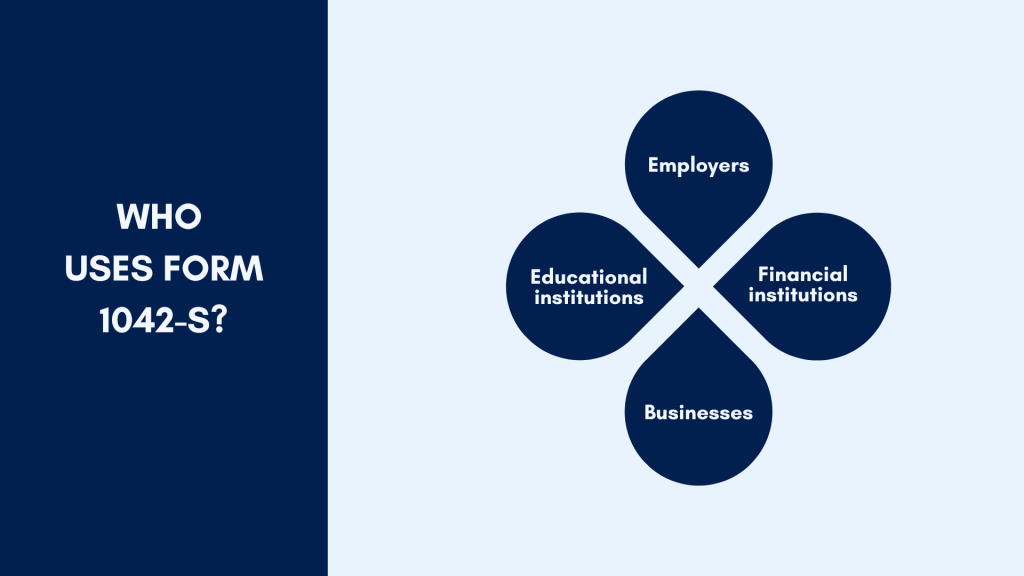Managing a business involves navigating a myriad of financial responsibilities, and when it comes to dealing with non-U.S. citizens or entities receiving income in the United States, the IRS Form 1042-S takes center stage.
In this article, we’re speaking about Form 1042-S, a crucial document filed by withholding agents to report U.S. source income paid to foreign individuals and entities: from understanding its purpose to navigating the essential components.
Key takeaways
- Form 1042-S is crucial for U.S. entities to report income paid to foreign individuals and entities, ensuring accurate documentation and appropriate taxation.
- The form includes a wide range of payment types like wages, interest, dividends, and scholarships, which helps maintain compliance with U.S. tax laws.
- Proper and timely filing of Form 1042-S is vital for businesses to avoid penalties, with a filing deadline of March 15th and specific requirements for accurate reporting and electronic submission.
Level up your accounting with smart automation! Integrate financial data from all your sales channels in your accounting to have always accurate records ready for reporting, analysis, and taxation. See it in action with a 15-day free trial or spare a spot at our weekly public demo to have your questions answered.
What is the purpose of form 1042-S?
Think of Form 1042-S as a tool that helps the U.S. government keep track of payments made to people or groups from outside the country. It’s not just about reporting the income; it’s about making sure everyone pays the right amount of taxes.
Those in charge of withholding tax, like employers or universities, use this form to report various types of income, such as dividends or scholarships, even if they didn’t withhold any taxes.
Understanding the role of form 1042-S
This form is a way for the government to double-check that everyone is following the tax rules. Filling out Form 1042-S correctly is not just about following the rules; it’s a smart move for businesses because it helps them avoid penalties and legal trouble.
For businesses dealing with international transactions, getting Form 1042-S right is not just about following the law; it’s a strategic move to protect the business from potential problems.
Who uses form 1042-S and what types of payments does It cover?
Understanding who uses Form 1042-S and what types of payments it covers helps ensure compliance with U.S. tax laws and proper reporting to the IRS. So, let’s figure it out.
Form 1042-S, officially titled “Foreign Person’s U.S. Source Income Subject to Withholding,” is primarily used by U.S. entities that make payments to foreign persons.

- Employers
Companies that hire foreign employees and make payments to them. - Financial institutions
Banks and other financial entities that handle interest, dividends, and other financial transactions involving foreign persons. - Educational institutions
Universities and colleges that provide scholarships, grants, or other financial assistance to international students and scholars. - Businesses
Any U.S.-based business that makes payments to foreign vendors, contractors, or service providers.
Making it short, if a U.S. person or organization pays income to a foreign person, they are responsible for filing Form 1042-S to report those payments to the Internal Revenue Service (IRS) and to the foreign recipient.
What types of payments does it cover?
Form 1042-S covers a broad range of income types that are subject to withholding. The main categories include:
- Wages and salaries
Payments made to foreign employees working in the U.S. or for U.S. companies abroad. - Interest
Payments on bank accounts, bonds, and other financial instruments. - Dividends
Earnings distributed to foreign shareholders of U.S. corporations. - Royalties
Payments for the use of intellectual property, such as patents, trademarks, and copyrights. - Scholarships and fellowships
Financial aid provided to international students and researchers. - Pensions and annuities
Retirement payments made to foreign retirees. - Gambling winnings
Earnings from lotteries, casinos, and other forms of gambling. - Rents
Payments for the use of real property located in the U.S. - Compensation for services
Payments to foreign contractors or service providers for work performed either in the U.S. or abroad if connected with U.S. business operations.
It’s important to note that not all types of income received by foreign persons are subject to withholding or reportable on Form 1042-S. Certain payments may be exempt under various tax treaties between the U.S. and other countries. In such cases, the foreign recipient needs to provide documentation, typically through Form W-8BEN, to claim the exemption.
How is reporting income handled, and when should form 1042-S be filed?
When it comes to reporting income, there’s a bit of a dance between Form 1042-S and another form called W-2. While W-2 is for reporting wages, Form 1042-S comes into play when someone’s earnings are exempt from income tax because of a tax treaty.
Treaty considerations
For example, if there’s a tax treaty between two countries, like Morocco and the U.S., Form 1042-S helps report income that’s exempt from taxes. In such cases, both W-2 and Form 1042-S are needed.
Filing deadlines and electronic submission
Filling out Form 1042-S has specific deadlines, and for those dealing with a lot of forms, submitting them electronically is not just a choice; it’s a rule. Financial institutions, especially, have to follow this rule.
What information is critical on form 1042-S, and how are codes used?
Form 1042-S has some important boxes, each with specific information. From the type of income to the amount paid, every detail matters. Understanding the purpose of each box, especially those with codes and exemption indicators, is essential for accurate reporting.
Deciphering box contents
Every box in Form 1042-S has a specific job, like Box 1, which tells the type of income. If there are multiple payments, each one needs its own form. Box 2 shows how much was paid, including any tax withheld. Meanwhile, Box 3 tells whether the withholding falls under Chapter 3 or 4.
Crucial exemption codes and tax rates
Some boxes have codes and rates that are vital for cases where tax withholding might be reduced or exempted. Figuring out which code or rate to use is like solving a puzzle, and getting it right is important to follow IRS rules.
Beyond numbers: withholding allowance and total withholding credit
Boxes 5 and 10 might seem a bit technical, but they are important for certain types of income. Even if no tax was taken out, Box 10 still needs to be filled in. It’s not just a paperwork thing; it’s a rule according to the IRS.
When and how should form 1042-S be filed to avoid penalties?
Filing form 1042-S on time is not just a rule; it’s a smart move to avoid problems. The rule is simple: one form for each calendar year. Extensions are possible, but they don’t give extra time to pay taxes. Businesses need to be careful to avoid late filing or payment, which can lead to extra charges.
Filing deadlines and extensions
The clock is ticking towards the March 15th deadline, and businesses need to file one form for each type of income paid. Extensions can be requested, but it’s crucial to remember that this doesn’t give extra time to pay taxes. It’s just for the paperwork.
Electronic filing mandate
The IRS prefers electronic filing, especially for those dealing with lots of forms. Financial institutions have to follow this rule, and it’s not just about keeping up with technology; it’s about efficiency and accuracy.
Bottom line
As you can see, form 1042-S is like a guide, helping businesses report income for those outside the U.S. It’s not just a piece of paper; it’s a strategic tool to follow tax rules, avoid penalties, and understand the details of different types of payments. The key takeaways here are simple but crucial: be accurate, follow deadlines, and understand the codes and rules on Form 1042-S. It’s not just about paperwork; it’s about smart business practices.
Continue reading: Learn how to void a check in QuickBooks Desktop.
Share your thoughts
Share your opinion or experience in the comment’s section below. We’d love to hear from you!

%20(1).png)





